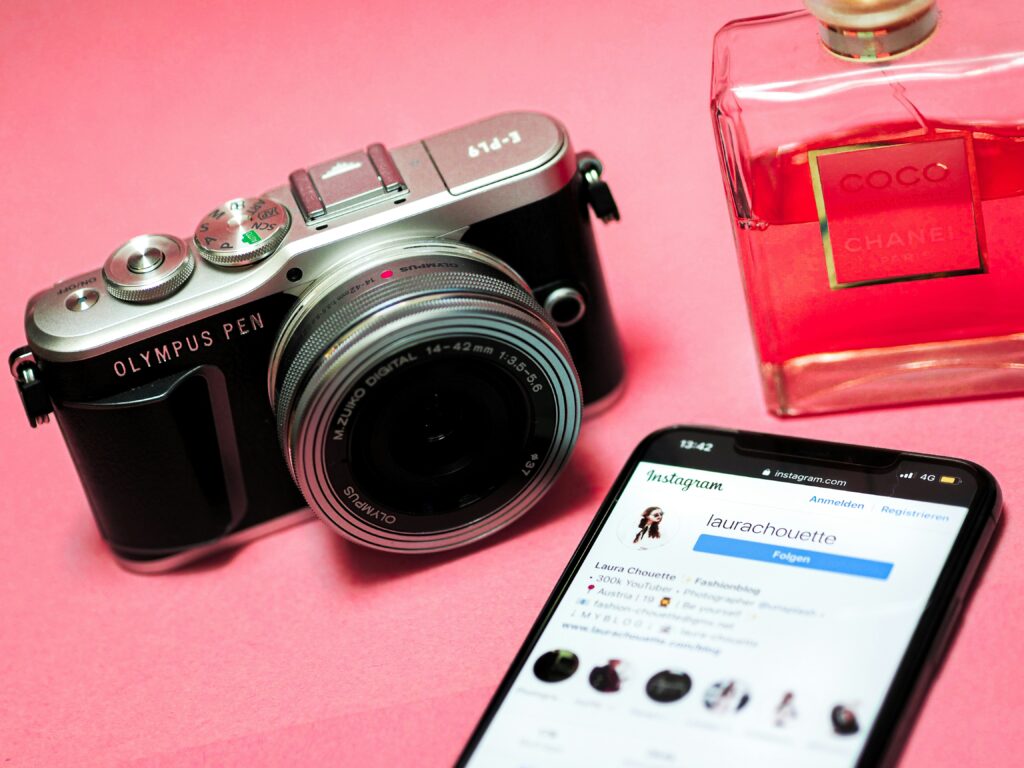An influencer is generally someone who has amassed a sizable social media following centred around a defined topic like fashion, travel or fitness. While mainstream celebrities typically attract fans from wider demographics, social media influencers advertising tend to cultivate specialised audiences deeply invested in their expertise.
A popular beauty influencer, for example, may have garnered hundreds of thousands of followers drawn to their makeup tutorials, reviews and style inspiration. These narrower but highly engaged communities give influencers the power to directly impact buying decisions – making their endorsements invaluable to marketers.
Influencer Marketing Explained
When you think “influencer marketing,” what likely comes to mind are overly sales-y product placements that feel forced. We’ve all seen Instagram posts littered with #ad hashtag disclosures that make our eyes glaze over. But influencer marketing wasn’t always that way. Done right, it can feel natural – like getting a personal recommendation from a friend whose taste you admire.
The key is blending sponsorships seamlessly into the creative content we initially followed an influencer for. Rather than repetitive sales pitches, effective influencer marketing features subtle appreciation for brands’ offerings organically woven into posts.
Think about some of your favourite social media personalities. When they highlight loving a new lipstick shade or sneaker style, it probably feels genuine coming from them. And that authenticity makes you far more likely to purchase compared to an annoying popup ad, right?

That ability for influencers to tap into true advocacy is what made brands take notice. As more creative individuals built engaged followings sharing their passions online, companies saw major opportunities to harness these connections.
Why Influencer Marketing Resonates
There are a few key advantages influencer marketing holds over other approaches that explain its thriving popularity:
Laser-focused reach
Influencers cultivate niche follower bases genuinely invested in their area of expertise. Brands can tap into this existing engagement rather than starting from scratch, trying to capture broad interest. Promotional messaging is more likely to resonate when shared with a highly targeted, relevant audience.
Trust and reliability
Recent data reveals an overwhelming 81% of consumers eagerly follow influencer endorsements versus traditional advertisements. Unlike distant celebrity spokespeople, influencers have cultivated an authentic connection with followers by candidly sharing their genuine, everyday lives, which breeds relatability and trust that boosts conversions.
Their content feels authentic because followers have connected with them over time by watching their day-to-day lives. Their endorsements carry weight because they know their niche inside and out.
Cost-effectiveness

In comparison to other forms of advertising and marketing, influencer marketing campaigns tend to offer a stronger ROI( Return on Investment). While mega influencers with millions of followers do charge hefty fees, brands can also partner with nano or micro-influencers who have under 100,000 followers at reasonable price points as part of an influencer strategy. Additionally, influencer posts frequently outperform paid ads in terms of engagement and click-through rates.
Creativity and brand storytelling
The best influencer campaigns allow influencers the freedom to get creative with branded content instead of handing them strict promotional messaging. Followers respond well to influencers telling compelling stories about new products versus sounding overly sales-y. From emojis covering a brand name in photos to giveaways encouraging user-generated content, influencer content feels more inspired and engaging.
These unique advantages of influencer marketing explain why partnering with social media influencers’ advertising has become a go-to influencer strategy. In fact, industry experts predict sponsored influencer posts will overtake branded website traffic in the near future. As influencers continue growing their brands, they present massive opportunities for all sorts of companies to connect with target demographics through an influencer strategy.
Choosing the Right Influencers
Choosing the right influencers is like matchmaking – each unique brand needs an ideal content creator fit. Rather than just chasing vanity metrics like followers, dig deeper in vetting.
- First, get clear on who your dream customer is and what campaign success looks like. This vision makes spotting aligned influencers far easier. Now, put yourself in your audience’s shoes – whose posts would you genuinely get excited to see in your feed?
- Search relevant hashtags and see who creates compelling content tailored to your niche. Analyse audience demographics, engagement levels, and recent partnerships as well. The goal is to find influencers who would rave about your products even without payment.
- Avoid creators willing to shill just anything for money without deep fit – the authenticity lacks and engagement suffers. But when you discover influencers as jazzed about your brand as you are? That’s when the magic happens.
So take time playing matchmaker. Vet thoroughly, get selective and partner only with influencers who align with your brand’s identity. Do this, and prepare for ideal demographics to start organically discovering and sharing your products far and wide.
Best Practices for Influencer Campaigns
Before formally starting any influencer partnership, it’s essential to get completely aligned. Walk them through the background on your brand’s identity, products, target audiences and campaign vision. Getting influencers immersed in your strategy lets them activate their talents accurately.
Then co-create a creative brief: Define ideal deliverable types, posting cadences, suggested messaging angles and exact branded elements to incorporate like discount codes and images.

Additionally, mutually agree upon time expectations, usage rights and approval protocols to prevent mid-campaign hiccups. Top influencers have handy media kits and contracts to codify details formally from the start. Taking this onboarding time upfront allows you both to hit the ground running with shared frameworks once launch day finally arrives. It lays the foundation for collaborative success.
Speaking of setting up both the brand and social media influencers advertising for success, a few other best practices to keep in mind include:
- Giving the influencer creative freedom to showcase branded products through their unique lens using social media influencers’ advertising. Overly dictating exact post copy or verbiage typically backfires.
- Developing multi-phase influencer partnerships for amplified impact over time versus limiting to one-off posts.
- Avoiding overly promotional language in post captions and instead favouring influencer storytelling focused on real user experience.
- Encouraging influencers to disclose sponsorships through branded hashtags and tags where their followers expect them.
- Implementing thorough tracking links, codes, pixels, or tags to monitor performance and optimise future campaigns.
Combining these best practices with diligent upfront vetting and expectations setting will lead to fantastic influencer campaign results.
Ultimately, influencer collaborations thrive as mutually beneficial partnerships aligning brand and creator incentives to serve niche audiences authentically. When both support the other’s success, brands access engaged communities while influencers fund content and expand personal brands – everybody wins.
Emerging Influencer Marketing Platforms
Influencer marketing going mainstream sparked a race to streamline partnerships at scale. Cue the rise of matchmaking platforms promising precision versus manual guesswork. Imagine no more aimless DMing, getting lost in comment sections, or scrolling through endless hashtags hoping to discover aligned social media influencers advertising. These sites automate the heavy lifting to uncover your ideal advocates.
Input your campaign goals and specify perfect partner criteria – niche, demographics, content style, location and more. Cutting-edge algorithms instantly sift through millions of social media influencers advertising to pinpoint the best matches for you.
Easily review granular audience data, engagement metrics and past campaign performance to vet suggestions. You’ll discover genuine resonators offering authentic cultural relevance versus random guesses.
Some platforms even fully automate ongoing campaign management, from casting calls to product seeding to performance tracking. These all-in-one platforms provide turnkey infrastructure to seamlessly scale collaborative success.
Kiss influencer marketing guesswork goodbye, thanks to matchmaking sites. Let the tech mathematically uncover your highest calibre creator partners in minutes based on precision parameters. Then, put those premium analytics, rights management and scaling tools to work, achieving ROI compounding.
Micro and Nano-Influencers Trending
- When influencer marketing first emerged, brands pursued collaborations with mega-influencers boasting millions of followers and charged enormous fees.
- Over time, brands realised follower count alone shouldn’t guide decisions. Engagement and relevance matter more.
- Micro and nano-influencers have smaller yet highly engaged niche communities based on shared interests. They lack raw followers but foster unusually strong connections and trust.
- Engagement rates (likes, comments, etc. per follower) for micro and nano-influencers consistently surpass those of broad mega-influencers.
- Smaller influencers offer better value compared to celebrity-level payouts. Their endorsements seem more genuine to followers who discover them through common interests versus fame.
- Followers view micro influencer endorsements as less transactional and more credible, since these influencers authentically use and document products they enjoy. This converts followers into buyers.
- In summary, relevance is more valuable than reach alone in influencer marketing. Micro and nano-influencers win on engagement and authenticity, making them pivotal partners compared to celebrity deals focused on vanity metrics like followers.
The Human Side of Influencing
It’s easy to see influencers as mere promotion vehicles. But behind each account lives multifaceted people – creators pouring their passion into content to spark impact.
Beyond seeing creators solely as vehicles for promotion, brands need to remember there are real people behind each influencer persona curating communities online. Just as brands aim for profitable sustainability, most influencers envision actualising deeper missions beyond money through their platforms over time.

Of course, creators have bills to pay and business ambitions the same as any other entrepreneur. Reasonable brand deals help subsidise creating content they believe in. But overtly transactional arrangements asking them to shill products feeling inauthentic to their brands go against sustaining community trust long-term.
Take a minute to envision the human side: endlessly brainstorming video ideas, meticulously editing shots, thoughtfully responding to every comment. Influencers invest tremendous work out of devotion to move audiences, not just rack up likes.
The ideal win-win partnerships instead align mutual incentives. When creators receive financial support to fuel their purpose-driven missions of uplifting niche audiences, incredible ROI potential unlocks while integrity remains intact.
So take time getting to know potential partners beyond metrics – discover multidimensional creators passionate about their space. Identify shared ideals between brand and influencer. Build collaboratively from places of authentic connection, not detached transactions. This human-centric foundation sets the stage for exceptional storytelling, organic reach and conscience-clear conversions on both sides.
In Closing
In many ways, the thriving world of influencer marketing has brought advertising strategies full circle back to old-school word-of-mouth product pitches. Only now, instead of recommendations spreading through small circles alone, social media influencers advertising broadcast to millions instantly. It allows brands struggling to cut through digital noise to borrow the organic voices followers have welcomed into their daily lives.
Of course phenomenons growing at breakneck speed inevitably experience maturity. As more brands populate the space, standing out requires renewed creativity. Yet for those who respect influencers as collaborators rather than commodities, commit to transparency with audiences and deliver value beyond sales pitches alone – the opportunities remain monumental.
Frequently Asked Questions
What are the different types of influencers like mega, macro, micro, and nano?
Mega-influencers have over 1 million followers, macro-influencers have between 100,000–1 million followers, micro-influencers have between 10,000–100,000 followers, and nano-influencers have less than 10,000 followers.
How do you measure the effectiveness of an influencer marketing campaign? What key metrics should brands track?
Key metrics to track include engagement rate, clicks, conversions/sales, reach, impressions, etc. Compare performance across influencers and platforms to determine ROI.
How much do influencers charge for branded partnerships? Does it vary based on follower count?
Influencer rates vary greatly based on factors like follower count, engagement levels, content quality/creativity, and campaign specifics. Micro-influencers often charge a few hundred per post, while celebrity mega-influencers charge over $100k.
What legal and FTC guidelines should brands follow when running influencer campaigns?
Brands must ensure influencers clearly disclose sponsored posts and comply with FTC endorsement guidelines. Both parties should document terms in a formal contract.
What are some best practices for working with influencers on sponsored social media posts? How much creative freedom should they have?
Give influencers reasonable creative licence to ensure content seems authentic versus overly salesy. Provide a creative brief defining campaign goals, brand messaging, ideal content types, and assets to incorporate.




